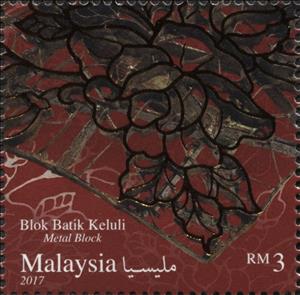Stamp: Metal Block (Malaysia 2017)
Metal Block (Malaysia 2017)
20 June (Malaysia ) within release Malaysian Batik goes into circulation Stamp Metal Block face value 3 Malaysian ringgit
| Stamp Metal Block in catalogues | |
|---|---|
| Michel: | Mi: MY 2351 |
| WADP Numbering System - WNS: | WAD: MY 045.17 |
Stamp is square format.
Batik is an important traditional handicraft in Malaysia, and the majority of batik in Malaysia is produced in the East coast region in Kelantan, Terengganu and Pahang. Malaysian batik usually uses motifs such as flowers, foliage and geometric designs.Also in the issue Malaysian Batik:
- Stamp - Malaysian Batik face value 0.60;
- Stamp - Malaysian Batik face value 0.60;
- Stamp - Malaysian Batik face value 0.80;
- Stamp - Malaysian Batik face value 0.80;
- Stamp - Malaysian Batik face value 0.90;
- Stamp - Malaysian Batik face value 0.90;
- Stamp - Malaysian Batik face value 3.00;
- Stamp - Malaysian Batik face value 3.00;
- Mini Sheet - Malaysian Batik face value ;
- Stamp - Batik Block - Design face value 60;
- Stamp - Batik Block - Stamping face value 60;
- Stamp - Metal Block face value 3;
- Stamp - Canting Batik - Melted Wax On Fabric face value 80;
- Stamp - Tie & Dye Batik - Design face value 90;
- Stamp - Tie & Dye Batik face value 90;
- Stamp - Canting Batik - Design face value 80;
- Souvenir Sheet - Metal Block & Wood Block face value 2*3;
- Stamp - Wood Block face value 3;
Stamp Metal Block it reflects the thematic directions:
Textile is an umbrella term that includes various fiber-based materials, including fibers, yarns, filaments, threads, and different types of fabric. At first, the word "textiles" only referred to woven fabrics.However, weaving is not the only manufacturing method, and many other methods were later developed to form textile structures based on their intended use. Knitting and non-woven are other popular types of fabric manufacturing. In the contemporary world, textiles satisfy the material needs for versatile applications, from simple daily clothing to bulletproof jackets, spacesuits, and doctor's gowns
Trade involves the transfer of goods and services from one person or entity to another, often in exchange for money. Economists refer to a system or network that allows trade as a market.
A tradition is a system of beliefs or behaviors (folk custom) passed down within a group of people or society with symbolic meaning or special significance with origins in the past. A component of cultural expressions and folklore, common examples include holidays or impractical but socially meaningful clothes (like lawyers' wigs or military officers' spurs), but the idea has also been applied to social norms and behaviors such as greetings, etc. Traditions can persist and evolve for thousands of years— the word tradition itself derives from the Latin word tradere literally meaning to transmit, to hand over, to give for safekeeping. While it is reportedly assumed that traditions have an ancient history, many traditions have been invented on purpose, whether it be political or cultural, over short periods of time. Various academic disciplines also use the word in a variety of ways.



